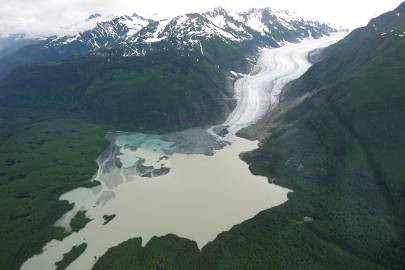There are over 100,000 glaciers in Alaska, predominantly in the Southeast, Southcentral, and Central regions, spanning approximately 75,000 square kilometers of the state. Of these glaciers, only about 600 are named, and even fewer are studied in extensive detail. Because the majority of the glaciers in Alaska lie in remote and difficult to access regions, most information obtained about them is in the form of satellite remote-sensed data. Thus, fieldwork and observations make important contributions to our understanding of glacier processes for the ability to verify scientific data on the ground. Numerous glacial research projects are currently underway in Alaska, focusing on topics ranging from crevasse formation to glacial flow rates, paleoclimatology (the study of past climates), and glacial retreat/growth. Across the board, scientists are interested in the fine mechanics of ice movement and glacial response to climate change so as to understand how glaciers impact the global economy, community, and environment.
But what is a glacier? And what makes them so important to the climate? This article will explore the basics of glaciology, climate science, and Alaskan geography in order to provide more information about the mechanics of these flowing masses of ice seen across the state of Alaska, and throughout the frozen regions of the world, known as the cryosphere.
Glacial Mechanics – How do they work?
To begin, a glacier can be thought of as a large river of ice moving slowly downhill under the force of gravity. Throughout the world, glaciers come in two main categories: polar and temperate. Polar glaciers are characterized by sub-freezing temperatures that allow the ice to remain frozen to its underlying bedrock, whereas temperate glaciers remain at or above freezing (0˚C) throughout their profiles. Ice that remains at 0˚C is quite warm and remains at its pressure-melting point, resulting in quicker movement across landscapes due to the introduction of meltwater at the base of the glacier-bedrock interface. Therefore, the main difference between these types of glaciers is the speed at which they flow and erode the bedrock upon which they reside. Because temperate glaciers often have meltwater present at their base, they can slide along the bedrock through a process called basal sliding, as well as within the ice column through internal deformation. Internal deformation is responsible for the majority of polar glacial flow, hence their slower rates. The other main difference is where these glaciers are found geographically. Typically, temperate glaciers reside in more moderate polar and circumpolar climates, such as in coastal Alaska, New Zealand, and continental Europe, to name a few. Polar glaciers, on the other hand, are commonly found in Antarctica and Greenland, where the temperatures often remain below freezing.
Beyond temperate and polar classifications, glaciers come in many different shapes and sizes. A detailed description of the different types of glaciers can be found here. Most common in Alaska are cirque, valley, tidewater, mountain, piedmont, and hanging glaciers. Of the many glaciers in the Valdez area, Alaska Guide Company offers tours to the Worthington and Valdez Glacier, both temperate cirque and valley glaciers, respectively. The Columbia and Shoup tidewater glaciers are accessible by sea kayak and water taxi, and connect to the broader Chugach Mountain Range. Over the past few years, all of the glaciers in the Valdez region have receded considerably, and will continue to do so. Check out a visual timeline of the Valdez Glacier here.


